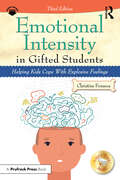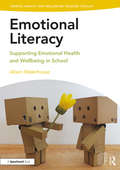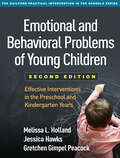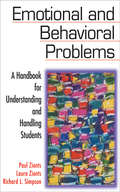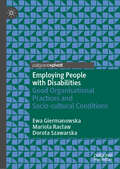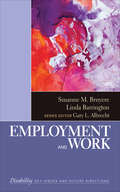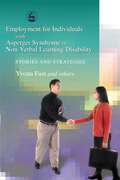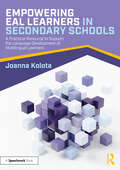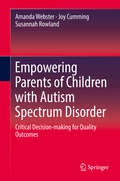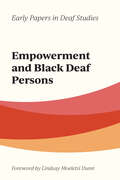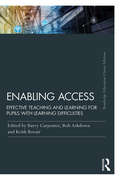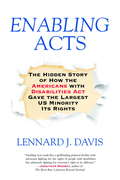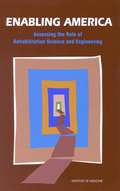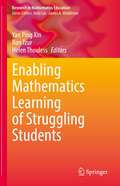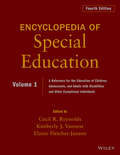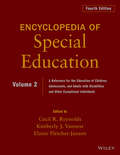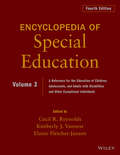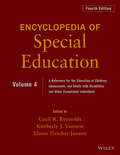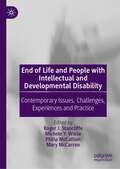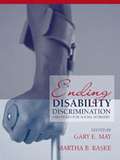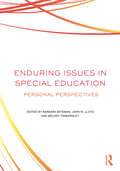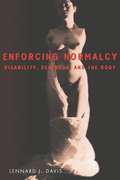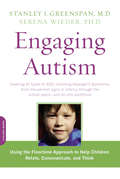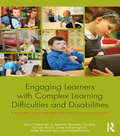- Table View
- List View
Emotional Intensity in Gifted Students: Helping Kids Cope With Explosive Feelings
by Christine FonsecaTeaching children how to manage their intense emotions is one of the most difficult aspects of parenting or educating gifted children. Emotional Intensity in Gifted Students is an indispensable resource for parents and educators seeking to understand why gifted children can be so extreme in their behavior and how to manage the highs and lows that accompany emotional intensity. Presented in an easy-to-read, conversational style, this revised and updated third edition pulls from contemporary research to depict changes in how we understand and support gifted children as well as an increased understanding of trauma, social-emotional learning, and empathy development. Chapters feature role-plays and strategies designed to show parents and teachers how to interact and guide gifted children in a way that teaches them how to recognize, monitor, and adjust their behavior. Also featuring updated resources, worksheets, and checklists, this practical new edition is a must-read for anyone wishing to make a positive and lasting impact on the lives of gifted children.
Emotional Literacy: Supporting Emotional Health and Wellbeing in School (Mental Health and Wellbeing Teacher Toolkit)
by Alison WaterhouseOne of the five books in the Mental Health and Wellbeing Toolkit for teachers and other professionals working with children, this practical resource focuses on the topic of ‘Emotional Literacy’ and how to support children and young people on a journey of self-discovery where they learn to recognise, understand, share and manage a range of emotions. Promoting a proactive rather than a reactive approach to dealing with the social and emotional aspects of learning and managing the world of today, Emotional Literacy addresses the increasing number of mental health issues arising among young people. Chapters span key topics including Recognising Emotions, Understanding Emotions, Self-Regulation and Empathy. This book offers: • Easy to follow, and flexible, lesson plans that can be adapted and personalised for use in lessons or smaller groups or 1:1 work. • Resources that are linked to the PSHE and Wellbeing curriculum for KS1, KS2 and KS3. • New research, ‘Circles for Learning’, where the introduction of baby observation into the classroom by a teacher is used to understand and develop self-awareness, skills for learning, relationships, neuroscience and awareness of others. • Sections on the development of key skills in communication, skills for learning, collaboration, empathy and self-confidence. • Learning links, learning objectives and reflection questions. Offering research-driven, practical strategies and lesson plans, Emotional Literacy is an essential resource book for educators and health professionals looking to have a positive impact on the mental health and wellbeing of the children in their care; both now and in the future.
Emotional and Behavioral Problems of Young Children, Second Edition: Effective Interventions in the Preschool and Kindergarten Years
by Gretchen Gimpel Peacock Jessica Malmberg Melissa L. HollandPresenting interventions that are practical, effective, and easy to implement in educational and clinical settings, this book addresses the most frequently encountered emotional and behavioral problems in 3- to 6-year-olds. Strategies for collaborating with parents are emphasized. Practitioners are taken step by step through assessing and treating conduct problems, anxiety and other internalizing problems, toileting difficulties, picky eating and related concerns, and sleep problems. User-friendly features include 36 reproducible parent handouts, assessment forms, and other clinical tools; the print book has a large-size format with lay-flat binding for easy photocopying. Purchasers get access to a Web page where they can download and print the reproducible materials. This book is in The Guilford Practical Intervention in the Schools Series. New to This Edition *Reflects over a decade of research advances, plus new assessments and interventions. *Updated for DSM-5. *Chapter on intervention within a multi-tiered system of support (MTSS). *Chapter on referral procedures for complex problems. *Mindfulness techniques for both parents and children. *Cutting-edge ways to use acceptance and commitment therapy principles and motivational interviewing with parents. *23 new or revised reproducible tools.
Emotional and Behavioral Problems: A Handbook for Understanding and Handling Students
by Richard L. Simpson Paul Zionts Laura T. ZiontsThe authors take a complex, under-discussed topic and give teachers and administrators useful, basic guidelines they can put to use quickly in understanding, identifying, and helping this special group of students.
Employing People with Disabilities: Good Organisational Practices and Socio-cultural Conditions
by Ewa Giermanowska Mariola Racław Dorota SzawarskaDeveloping better employment and management practices for a diverse workplace is quickly becoming a major concern amongst most modern organisations; however, a lack of research into good practices has a limiting effect. Dealing specifically with disabilities, this pioneering work is based on international research spanning several European countries to demonstrate best practice. Aiming to fill a gap in knowledge, the authors offer interdisciplinary insights into managing diversity in the workplace, taking into account various social and cultural contexts. Providing analysis and recommendations for adapting organisational practices to different workplace settings, this Palgrave Pivot is a vital read for scholars of HRM and diversity management, as well as policy-makers and practitioners.
Employment and Work (The SAGE Reference Series on Disability: Key Issues and Future Directions)
by Susanne Marie Bruyère Linda BarringtonThis volume in The SAGE Reference Series on Disability explores issues facing people with disabilities in employment and the work environment. It is one of eight volumes in the cross-disciplinary and issues-based series, which incorporates links from varied fields making up Disability Studies as volumes examine topics central to the lives of individuals with disabilities and their families. With a balance of history, theory, research, and application, specialists set out the findings and implications of research and practice for others whose current or future work involves the care and/or study of those with disabilities, as well as for the disabled themselves. The presentational style (concise and engaging) emphasizes accessibility. Taken individually, each volume sets out the fundamentals of the topic it addresses, accompanied by compiled data and statistics, recommended further readings, a guide to organizations and associations, and other annotated resources, thus providing the ideal introductory platform and gateway for further study. Taken together, the series represents both a survey of major disability issues and a guide to new directions and trends and contemporary resources in the field as a whole.
Employment for Individuals with Asperger Syndrome or Non-Verbal Learning Disability: Stories and Strategies
by Yvona FastMost people with Non-Verbal Learning Disorder (NLD) or Asperger Syndrome (AS) are underemployed. This book sets out to change this. With practical and technical advice on everything from job hunting to interview techniques, from 'fitting in' in the workplace to whether or not to disclose a diagnosis, this book guides people with NLD or AS successfully through the employment mine field. There is also information for employers, agencies and careers counsellors on AS and NLD as 'invisible' disabilities, including an analysis of the typical strengths of somebody with NLD or AS, and how to use these positively in the workplace. Practical information and lists of career resources are supported by numerous case studies to inspire and advise. An essential resource for people with NLD or AS seeking or in employment and their existing or potential employers.
Empowering EAL Learners in Secondary Schools: A Practical Resource to Support the Language Development of Multilingual Learners
by Joanna KolotaOne in five students are identified as speaking English as an Additional Language (EAL) and all teachers are highly likely to be teaching multilingual students in their classrooms. As our schools become more culturally and linguistically diverse, they must respond to the needs of the students in front of them, and this book provides a range of strategies and resources to ensure teaching is adaptive and responsive so that all learners thrive and fulfil their academic potential.At the heart of the book is developing an understanding of how languages are acquired and an awareness that all students, regardless of their current English language proficiency, need to be offered a challenging and supportive environment. Chapters offer: High-yielding, practical approaches and strategies to ensure that students are able to access content-appropriate lessons and simultaneously develop their language A plethora of resources and step-by-step examples, showcasing how explicit vocabulary and grammar learning can be context-based for the benefit of all learners Each teacher is positioned as a language teacher, with the responsibility of planning sessions where language is not perceived as an add-on, but as an integral and pivotal part. This book will empower you as an educator and ensure that your classroom is a language-aware and stimulating environment for your students. It will be essential reading for all secondary school educators and teaching assistants who support EAL students in mainstream lessons and are responsible for producing resources and implementing classroom strategies.
Empowering Parents of Children with Autism Spectrum Disorder
by Amanda Webster Joy Cumming Susannah RowlandThis book presents an international research-based framework that has empowered parents of children with autism spectrum disorder (ASD) to become critical decision makers to actively guide their child's learning and self-advocacy. Parents can use this framework to identify their child's vision and dreams, and to work with educators and service providers to establish specific learning goals and to implement effective interventions and programs that enable their child to achieve those goals and realise their vision for the future. The book begins by reviewing available research on evidence-based practice for children with ASD and outlining the Cycle of Learning decision-making framework for parents and professionals. Throughout the remainder of the book, case studies are presented to illustrate the ways in which different parents have successfully utilised this framework to develop effective plans for their child and to advocate for learning and education programs for both their child and other children with ASD in school and community settings. In addition, it highlights concrete examples of how parents have used the framework to empower their children with ASD to develop their self-awareness and self-determination, and to be able to self-advocate as they move through adolescence and into adult life.
Empowerment and Black Deaf Persons (Early Papers in Deaf Studies #1)
by Lindsay Moeletsi DunnEmpowerment and Black Deaf Persons is a collection of papers from a 1990 conference that brought together an audience of mostly Black Deaf and hearing people to address three themes: leadership and advocacy, the dynamics and dilemmas of being multiply marginalized, and issues related to language and community. Scholars, students, and community members will find this volume invaluable for understanding the origins and evolution of Black Deaf Studies. Lindsay Dunn, co-chair of the original conference, contributes a new foreword, offering contemporary insights and reflections. This is the inaugural volume in the Early Papers in Deaf Studies series, which will consist of reissued works originally published by the Gallaudet University College for Continuing Education but long out of print. The aim of this series is to restore these foundational papers to the scholarly community. Empowerment and Black Deaf Persons is available in both print and open digital formats, ensuring broad access to this important contribution to the literature.
Enabling Access: Effective Teaching and Learning for Pupils with Learning Difficulties
by Barry Carpenter Rob Ashdown Keith BovairThis Routledge Classic Edition brings together widely experienced editors and contributors to show how access to a whole school curriculum can be provided for learners with moderate to profound and multiple learning difficulties. Along with a new appraisal of the contents from the editors, the contributors raise debates, illustrate effective teaching ideas and discuss strategies for providing a high-quality education for these pupils and a celebration of their achievements. The book also discusses the active involvement of family members and the learners themselves in these processes and considers issues surrounding empowerment of learners, professional development of the workforce and curriculum principles such as differentiation, personalisation, and engagement. Winner of the prestigious nasen/TES Academic Book Award in 1996, Enabling Access is an essential read for students and lecturers in higher education, and for teachers, support staff, and other professionals in all educational settings in the UK and abroad catering for these learners.
Enabling Acts
by Lennard J. Davis<P>The first significant book on the history and impact of the ADA--the "eyes on the prize" moment for disability rights. <P>The Americans with Disabilities Act (ADA) is the widest-ranging and most comprehensive piece of civil rights legislation ever passed in the United States, and it has become the model for disability-based laws around the world. Yet the surprising story behind how the bill came to be is little known. <P>In this riveting account, acclaimed disability scholar Lennard J. Davis delivers the first behind-the-scenes and on-the-ground narrative of how a band of leftist Berkeley hippies managed to make an alliance with upper-crust, conservative Republicans to bring about a truly bipartisan bill. <P>Based on extensive interviews with all the major players involved including legislators and activists, Davis recreates the dramatic tension of a story that is anything but a dry account of bills and speeches. Rather, it's filled with one indefatigable character after another, culminating in explosive moments when the hidden army of the disability community stages scenes like the iconic "Capitol Crawl" or an event some describe as "deaf Selma," when students stormed Gallaudet University demanding a "Deaf President Now!" <P>From inside the offices of newly formed disability groups to secret breakfast meetings surreptitiously held outside the White House grounds, here we meet countless unsung characters, including political heavyweights and disability advocates on the front lines. "You want to fight?" an angered Ted Kennedy would shout in an upstairs room at the Capitol while negotiating the final details of the ADA. Congressman Tony Coelho, whose parents once thought him to be possessed by the devil because of his epilepsy, later became the bill's primary sponsor. There's Justin Dart, adorned in disability power buttons and his signature cowboy hat, who took to the road canvassing fifty states, and people like Patrisha Wright, also known as "The General," Arlene Myerson or "the brains," "architect" Bob Funk, and visionary Mary Lou Breslin, who left the hippie highlands of the West to pursue equal rights in the marble halls of DC. <P>Published for the twenty-fifth anniversary of the ADA, Enabling Acts promises to ignite readers in a discussion of disability rights by documenting this "eyes on the prize" moment for tens of millions of American citizens.
Enabling America: Assessing the Role of Rehabilitation Science and Engineering
by Andrew M. Pope Edward N. BrandtThe most recent high-profile advocate for Americans with disabilities, actor Christopher Reeve, has highlighted for the public the economic and social costs of disability and the importance of rehabilitation. Enabling America is a major analysis of the field of rehabilitation science and engineering. The book explains how to achieve recognition for this evolving field of study, how to set priorities, and how to improve the organization and administration of the numerous federal research programs in this area.The committee introduces the "enabling-disability process" model, which enhances the concepts of disability and rehabilitation, and reviews what is known and what research priorities are emerging in the areas of: Pathology and impairment, including differences between children and adults. Functional limitations--in a person's ability to eat or walk, for example. Disability as the interaction between a person's pathologies, impairments, and functional limitations and the surrounding physical and social environments. This landmark volume will be of special interest to anyone involved in rehabilitation science and engineering: federal policymakers, rehabilitation practitioners and administrators, researchers, and advocates for persons with disabilities.
Enabling Mathematics Learning of Struggling Students (Research in Mathematics Education)
by Yan Ping Xin Ron Tzur Helen ThoulessThis book provides prospective and practicing teachers with research insights into the mathematical difficulties of students with learning disabilities and classroom practices that address these difficulties. This linkage between research and practice celebrates teachers as learners of their own students’ mathematical thinking, thus contributing an alternative view of mathematical progression in which students are taught conceptually. The research-based volume presents a unique collaboration among researchers in special education, psychology, and mathematics education from around the world. It reflects an ongoing work by members of the International Group for the Psychology of Mathematics Education (PME) and the North American Chapter of the PME Working Groups. The authors of chapters in this book, who have been collaborating extensively over the past 7 years, are from Australia, Canada, the United Kingdom, and the United States.
Encyclopedia of Special Education, Volume 1: A Reference for the Education of Children, Adolescents, and Adults Disabilities and Other Exceptional Individuals
by Elaine Fletcher-Janzen Cecil R. Reynolds Kimberly J. VannestThe only comprehensive reference devoted to special education The highly acclaimed Encyclopedia of Special Education addresses issues of importance ranging from theory to practice and is a critical reference for researchers as well as those working in the special education field. This completely updated and comprehensive A-Z reference includes about 200 new entries, with increased attention given to those topics that have grown in importance since the publication of the third edition, such as technology, service delivery policies, international issues, neuropsychology, and RTI. The latest editions of assessment instruments frequently administered in special education settings are discussed. Only encyclopedia or comprehensive reference devoted to special education Edited and written by leading researchers and scholars in the field New edition includes over 200 more entries than previous edition, with increased attention given to those topics that have grown in importance since the publication of the third edition—such as technology, service delivery policies, international issues, neuropsychology, and Response to Intervention, Positive Behavioral Interventions and Supports (PBIS), Autism and Applied Behavior Analysis Entries will be updated to cover the latest editions of the assessment instruments frequently administered in special education settings Includes an international list of authors and descriptions of special education in 35 countries Includes technology and legal updates to reflect a rapidly changing environment Comprehensive and thoroughly up to date, this is the essential, A-Z compilation of authoritative information on the education of those with special needs.
Encyclopedia of Special Education, Volume 2: A Reference for the Education of Children, Adolescents, and Adults Disabilities and Other Exceptional Individuals
by Elaine Fletcher-Janzen Cecil R. Reynolds Kimberly J. VannestThe only comprehensive reference devoted to special education The highly acclaimed Encyclopedia of Special Education addresses issues of importance ranging from theory to practice and is a critical reference for researchers as well as those working in the special education field. This completely updated and comprehensive A-Z reference includes about 200 new entries, with increased attention given to those topics that have grown in importance since the publication of the third edition, such as technology, service delivery policies, international issues, neuropsychology, and RTI. The latest editions of assessment instruments frequently administered in special education settings are discussed. Only encyclopedia or comprehensive reference devoted to special education Edited and written by leading researchers and scholars in the field New edition includes over 200 more entries than previous edition, with increased attention given to those topics that have grown in importance since the publication of the third edition—such as technology, service delivery policies, international issues, neuropsychology, and Response to Intervention, Positive Behavioral Interventions and Supports (PBIS), Autism and Applied Behavior Analysis Entries will be updated to cover the latest editions of the assessment instruments frequently administered in special education settings Includes an international list of authors and descriptions of special education in 35 countries Includes technology and legal updates to reflect a rapidly changing environment Comprehensive and thoroughly up to date, this is the essential, A-Z compilation of authoritative information on the education of those with special needs.
Encyclopedia of Special Education, Volume 3: A Reference for the Education of Children, Adolescents, and Adults Disabilities and Other Exceptional Individuals
by Elaine Fletcher-Janzen Cecil R. Reynolds Kimberly J. VannestThe only comprehensive reference devoted to special education The highly acclaimed Encyclopedia of Special Education addresses issues of importance ranging from theory to practice and is a critical reference for researchers as well as those working in the special education field. This completely updated and comprehensive A-Z reference includes about 200 new entries, with increased attention given to those topics that have grown in importance since the publication of the third edition, such as technology, service delivery policies, international issues, neuropsychology, and RTI. The latest editions of assessment instruments frequently administered in special education settings are discussed. Only encyclopedia or comprehensive reference devoted to special education Edited and written by leading researchers and scholars in the field New edition includes over 200 more entries than previous edition, with increased attention given to those topics that have grown in importance since the publication of the third edition—such as technology, service delivery policies, international issues, neuropsychology, and Response to Intervention, Positive Behavioral Interventions and Supports (PBIS), Autism and Applied Behavior Analysis Entries will be updated to cover the latest editions of the assessment instruments frequently administered in special education settings Includes an international list of authors and descriptions of special education in 35 countries Includes technology and legal updates to reflect a rapidly changing environment Comprehensive and thoroughly up to date, this is the essential, A-Z compilation of authoritative information on the education of those with special needs.
Encyclopedia of Special Education, Volume 4: A Reference for the Education of Children, Adolescents, and Adults Disabilities and Other Exceptional Individuals
by Elaine Fletcher-Janzen Cecil R. Reynolds Kimberly J. VannestThe only comprehensive reference devoted to special education The highly acclaimed Encyclopedia of Special Education addresses issues of importance ranging from theory to practice and is a critical reference for researchers as well as those working in the special education field. This completely updated and comprehensive A-Z reference includes about 200 new entries, with increased attention given to those topics that have grown in importance since the publication of the third edition, such as technology, service delivery policies, international issues, neuropsychology, and RTI. The latest editions of assessment instruments frequently administered in special education settings are discussed. Only encyclopedia or comprehensive reference devoted to special education Edited and written by leading researchers and scholars in the field New edition includes over 200 more entries than previous edition, with increased attention given to those topics that have grown in importance since the publication of the third edition—such as technology, service delivery policies, international issues, neuropsychology, and Response to Intervention, Positive Behavioral Interventions and Supports (PBIS), Autism and Applied Behavior Analysis Entries will be updated to cover the latest editions of the assessment instruments frequently administered in special education settings Includes an international list of authors and descriptions of special education in 35 countries Includes technology and legal updates to reflect a rapidly changing environment Comprehensive and thoroughly up to date, this is the essential, A-Z compilation of authoritative information on the education of those with special needs.
End of Life and People with Intellectual and Developmental Disability: Contemporary Issues, Challenges, Experiences and Practice
by Philip McCallion Roger J. Stancliffe Michele Y. Wiese Mary McCarronThis book on end of life examines how to include people with intellectual and developmental disability in the inevitability of dying and death. Comprising 17 chapters, it addresses challenging and under-researched topics including suicide, do-not-resuscitate, advance care planning, death doulas and accessible funerals. Topics reflect everyday community, palliative care, hospice and disability services.The book proposes that the rights of people with disabilities should be supported up to and after their death. Going beyond problem identification, the chapters offer positive, evidence-supported responses that translate research to practice, together with practice examples and resources grounded in lived experience. The book is applicable to readers from the disability field, and mainstream health professionals who assist people with disability in emergency care, palliative care or end-of-life planning
Ending Disability Discrimination: Strategies For Social Workers
by Gary E. May Martha B. RaskeEnding Disability Discrimination defines disability as a social construction, not as an immutable physical limitation, and gives social work students and practitioners a model that can be used to transform how people with disabilities are treated.
Enduring Issues In Special Education: Personal Perspectives
by Barbara Bateman Melody Tankersley John Wills LloydEnduring Issues in Special Education is aimed at any course in the undergraduate or graduate special education curriculum that is wholly or partly devoted to a critical examination of current issues in special education. The book organizes 28 chapters into seven sections using familiar structuring principles—what, who, where, how, when, why, and whither. Each section begins with an introduction that provides historical, legal, and theoretical background information and organizing commentary for the chapters that follow. The book’s objective, in addition to informing readers about the issues, is to develop critical thinking skills in the context of special education. Key features include the following: Dialectic Format – Each of the 28 chapters presents compelling reasons for addressing the issue at hand and specific ways to do so. Because each issue is written from different perspectives and focuses on a variety of aspects, readers are encouraged to weigh the arguments, seek additional information, and come up with synthesized positions of their own. Organizing Framework – The book’s seven sections have been arranged according to a scheme that is the essence of most investigative reporting and provides a coherent, easy-to-understand framework for readers. Expertise – All chapters are written by leading scholars who are highly regarded experts in their fields and conclude with suggested readings and discussion questions for additional study.
Enforcing Normalcy: Disability, Deafness, and the Body
by Lennard J. DavisThis book tries to think through some of the complex issues raised by concepts such as the body, the normal, the abnormal, disability, the disabled, and people with disabilities. I wrote this book because I believe deeply that people with disabilities, Deaf people, and others who might not even consider themselves as having a disability have been relegated to the margins by the very people who have celebrated and championed the emergence of multiculturalism, class consciousness, feminism, and queer studies from the margins.
Engaging Autism: Using the Floortime Approach to Help Children Relate, Communicate, and Think (A Merloyd Lawrence Book)
by Stanley I. Greenspan Serena WiederGrateful parents and professionals worldwide have welcomed this essential guide to the highly recommended Floortime approach for treating children with any of the autism spectrum disorders (ASD). Now available in paperback, Engaging Autism includes new, exciting information on neuroscience research into the effects of this approach, plus guidance for parents navigating the controversies surrounding the treatment of autism. Unlike approaches that focus on changing specific behavior, Greenspan’s program promotes the building blocks of healthy emotional and behavioral development. He shows that, remarkably, children with ASD do not have a fixed, limited potential, and may often join their peers to lead full, psychologically healthy lives. The Floortime approach can also be applied at any age--including early infancy, when the first signs of risk for ASD may appear--so that preventing the full development of autism becomes a real possibility.
Engaging Learners with Complex Learning Difficulties and Disabilities: A resource book for teachers and teaching assistants
by Barry Carpenter Jo Egerton Beverley Cockbill Tamara Bloom Jodie Fotheringham Hollie Rawson Jane ThistlethwaiteChildren and young people with Complex Learning Difficulties and Disabilities (CLDD) have co-existing and overlapping conditions which can manifest in complex learning patterns, extreme behaviours and a range of socio-medical needs which are new and unfamiliar to many educators. Their combination of issues and layered needs – mental health, relationship, behavioural, physical, medical, sensory, communication and cognitive – mean they often disengage from learning and challenge even our most experienced teachers. This book provides school practitioners and leaders with an approach and resources to engage this often disenfranchized group of children in learning. The Engagement for Learning Framework has been developed and trialled by over 100 educational settings (both special and mainstream) with learners from early years to post-16. It gives practitioners from a range of disciplines a shared means of assessing, recording and developing personalized learning pathways and demonstrating progression for these children. The focus on inquiry means that however complex a young person’s needs, educators will be able to apply the approach. This practical and engaging book provides literature, tools and case study examples outlining who children and young people with CLDD are, why their engagement for learning is important and how the Engagement for Learning Framework can be used effectively by teachers and other professionals to ensure the best possible outcomes for these children.
